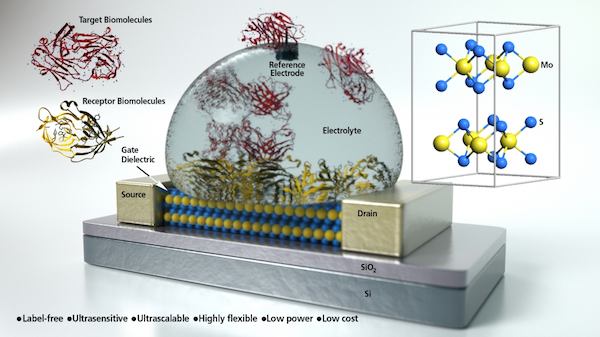
Molybdenum disulfide (MoS2) is a metal dichalcogenide dream date—the semiconductor’s relative unreactivity and low friction properties make it a great dry lubricant and an excellent cocatalyst in petroleum refining. Now new research from the University of California Santa Barbara suggests that it might have another use, too—as single molecule biosensors.
Biosensors detect biological analytes in solution—including proteins, DNA, and small molecules—and hence hold a lot of promise for revolutionizing future diagnostic processes in medical, agricultural, environmental, and forensic fields, among others.
Biosensors made from field effect transistors (FET) are kind of a big deal in the biosensors world—they’re incredibly sensitive, allow label-free and realtime detection, and support nondestructive sampling. (Click here for a review article in NPG Asia Materials for a little background info about FET biosensors from carbon nanomaterials.)
The key to building a really good biosensor lies in the bandgap of the material that makes up the sensor—the bandgap (the energy gap where no electron states can exist) determines a material’s electrical conductivity. Semiconductors have small bandgaps that act as a sort of switch to let the material toggle between insulating and conducting properties. Bandgaps on the larger end of the semiconducting range allow for better switching, as well as making the material a better insulator by reducing leakage—so a material used to make the ideal FET has to be just right.
Most research on FET biosensors has focused on those built of graphene, but the carbon wonder material has a zero bandgap. While this property that makes it interesting in many regards, it also makes graphene ill-suited for FET biosensors. With zero bandgap, graphene essentially has no switch—it can’t be shut off, so it is very leaky. And when it comes to FET biosensors, just like your kitchen sink, leaky is no good.
Unlike graphene, MoS2 has an excellent bandgap. Like graphene, it can be manufactured in atomically thin sheets. So MoS2 “surpasses graphene’s already high sensitivity, offers better scalability, and lends itself to high-volume manufacturing,” according to a UCSB press release.
“Monolayer or few-layer MoS2 have a key advantage over graphene for designing a FET biosensor: They have a relatively large and uniform band gap [1.2–1.8 eV, depending on the number of layers] that significantly reduces the leakage current and increases the abruptness of the turn-on behavior of the FETs, thereby increasing the sensitivity of the biosensor,” UCSB electrical and computer engineering professor Kaustav Banerjee says in the release.
From left: Deblina Sarkar, Kaustav Banerjee, and Smiar Mitragotri. Credit: UCSB
The UCSB scientists demonstrated that these properties make MoS2 an excellent material for FET biosensors. The biosensors they fabricated and described in their recent ACS Nano paper are 74-fold more sensitive than graphene FET biosensors—so sensitive that they can detect concentrations equivalent to a drop of milk in a hundred tons of water, according to the press release.
In the paper, the authors demonstrate that their MoS2 biosensors can sensitively detect pH changes in solution and can reliably detect biomolecules. They first tested the sensors’ ability to detect biomolecules biotin-streptavidin, a hallmark of molecular biology techniques for detecting biological interactions.
“Moreover, the channel length of MoS2 FET biosensor can be scaled down to the dimensions similar to those of small biomolecules such as DNA or small proteins, still maintaining good electrostatics, which can lead to high sensitivity even for detection of single quanta of these biomolecular species,” lead author and Ph.D. student Deblina Sarkar says in the release.
Although the team fabricated the thin MoS2 sheets through exfoliation—peeling off thin layers with a piece of adhesive tape—large scale synthesis of MoS2 has been previously described, so the authors speculate that large-scale synthesis of thin MoS2 is quite plausible.
“This invention has established the foundation for a new generation of ultrasensitive and low-cost biosensors that can eventually allow single-molecule detection—the holy grail of diagnostics and bioengineering research,” says Samir Mitragotri, co-author, chemical engineering professor, and director of the Center for Bioengineering at UCSB, in the release.
Concept of a molybdenum disulfide FET biosensor. Credit: Peter Allen; UCSB
If the team’s testing of MoS2 continues its excellent track record, these biosensors could soon find their way into a host of applications and products.
According to the release, “Biosensors based on conventional FETs have been gaining momentum as a viable technology for the medical, forensic and security industries since they are cost-effective compared to optical detection procedures. Such biosensors allow for scalability and label-free detection of biomolecules—removing the step and expense of labeling target molecules with florescent dye.”
The paper is “MoS2 field-effect transistor for next-generation label-free biosensors” (DOI: 10.1021/nn5009148).

